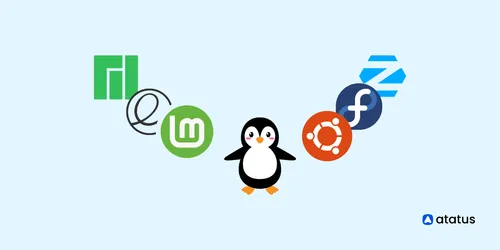Introduction to Linux: Why You Should Consider Shifting from Windows
 Sarvesh.Patil
Sarvesh.Patil
What is Linux?
Linux is an open-source operating system (OS) that's widely used across various industries, from personal computers to servers and even embedded systems. Unlike proprietary systems like Windows, Linux is built on a collaborative development model, meaning its source code is freely available for anyone to view, modify, and distribute. The most popular versions of Linux, also called "distributions" or "distros," include Ubuntu, Fedora, Debian, Arch Linux, and CentOS.
Linux is based on the Unix-like kernel, which makes it a highly stable, secure, and versatile OS. It's the backbone for many critical systems, including most of the internet’s infrastructure (web servers), Android smartphones, and supercomputers.
Why Shift to Linux from Windows?
Shifting from Windows to Linux can feel daunting at first, but there are several compelling reasons why many developers, system administrators, and even casual users make the switch.
Trust me after shifting to Linux from any other OS,
the first month of your YouTube search and Google search is going to be “How to install (This ) in Linux (Distro and version)“.
and “How to do this in Linux“, “Why Ubuntu users are cooler than Arch user'“ “What your linux distro speaks about your personality“ 🤣🤣🤣.
And to make your life easier, I suggest Shifting to Ubuntu distro… Any stable version of Ubuntu.
For making this experience easier i recommend joining
Ask Ubuntu (A StackOverFlow for Ubuntu people)
1. Open-Source & Free
Linux is free to download, install, and use. Most Linux distributions are completely open-source, which gives users complete control over their system. You no longer have to worry about licensing costs, activation keys, or compliance with proprietary software agreements.
2. Security
Linux is inherently more secure than Windows due to its robust permission and user role system. Since most of its components are open-source, vulnerabilities are quickly identified and fixed by the global developer community. Additionally, the relatively small number of Linux desktop users means fewer malware and virus threats compared to Windows.
3. Customization
Unlike Windows, which has many limitations when it comes to customization, Linux offers nearly endless flexibility. From the desktop environment to the file system, you can tailor Linux to your exact needs. This is great for developers who want a personalized working environment.
4. Performance & Resource Efficiency
Linux is highly efficient in terms of resource usage. It consumes less memory and CPU power compared to Windows, which leads to faster boot times and overall better performance, especially on older hardware. This makes it ideal for developers who need a lean system for programming, compiling code, or running multiple applications at once.
5. Privacy
Linux doesn't track user data like Windows. Since it’s open-source, you can inspect and understand what the OS is doing in the background. There's no telemetry collection or tracking, making Linux a more privacy-conscious choice.
6. Developer-Friendly
For developers, Linux offers built-in support for a variety of programming languages and frameworks like Python, Ruby, C, C++, Java, and more. It also integrates smoothly with Git, Docker, Kubernetes, and other modern development tools. The package management system (such as apt for Ubuntu or yum for Fedora) makes installing software and libraries straightforward.
7. Powerful Command Line Interface (CLI)
Linux’s terminal is extremely powerful and offers more control than the command prompt in Windows. Whether you're managing files, running scripts, or configuring services, the Linux command line is a developer's best friend. Mastering Linux commands can significantly enhance productivity.
Important Linux Commands Every Beginner Should Know
Before switching to Linux, it's essential to familiarize yourself with some fundamental terminal commands. Here's a short list to get you started:
ls- Lists the files and directories in the current working directory.bashCopy codels -l # Lists with details like file permissions, size, etc.cd- Changes directories.bashCopy codecd /home/user/Documents # Navigates to a specified directorypwd- Displays the current working directory.bashCopy codepwd # Shows the full path of the current directorycp- Copies files or directories.bashCopy codecp source_file.txt /path/to/destination/ # Copies a file to the specified directorymv- Moves or renames files and directories.bashCopy codemv old_name.txt new_name.txt # Renames a filerm- Removes (deletes) files or directories.bashCopy coderm -r /path/to/directory # Deletes a directory and its contentstouch- Creates a new, empty file.bashCopy codetouch newfile.txtcat- Displays the content of a file.bashCopy codecat file.txt # Prints the file content to the terminalsudo- Executes a command with superuser (admin) privileges.bashCopy codesudo apt-get update # Updates the system package listapt/yum/pacman- Linux package managers, used to install or update software.bashCopy codesudo apt install package_name # Installs a package on Ubuntu-based systemschmod- Changes file permissions.bashCopy codechmod +x script.sh # Makes a script executablegrep- Searches for specific patterns in files or outputs.bashCopy codegrep "search_term" file.txt # Finds a term within a file
What You Should Consider Before Switching to Linux
Before you switch from Windows to Linux, there are a few important considerations on must ensure for a smooth transition:
Compatibility with Software [NO GAMING ]
While most open-source development tools work seamlessly on Linux, some proprietary software (such as Adobe products or Microsoft Office) may not be natively supported. However, alternatives like GIMP (for image editing), LibreOffice (for document editing), and Wine (to run Windows applications) are available.File System Differences
Linux uses file systems like ext4 or Btrfs instead of NTFS. Understanding how Linux handles file permissions, symbolic links, and case sensitivity in file names is crucial, especially for developers working on cross-platform applications.Backup Your Data
Make sure to back up your data before switching. Moving from Windows to Linux may require partitioning your hard drive or even wiping your disk. Tools like Timeshift can help create system snapshots for easy recovery.Learning Curve
Linux can be intimidating for first-time users due to the reliance on the command line and different system conventions. Familiarize yourself with basic terminal commands and Linux filesystem hierarchy before making the switch.Dual Boot Setup
If you're not ready to fully commit to Linux, you can opt for a dual-boot setup where both Windows and Linux coexist on the same machine. This lets you boot into either OS, giving you the flexibility to transition gradually.Choosing the Right Distribution
Linux comes in many flavors (distributions), each tailored for specific use cases. Ubuntu is often recommended for beginners due to its large community and ease of use. If you're looking for a lightweight OS, Arch Linux or Manjaro may be better suited for you.Support for Development Tools
Ensure that the development tools and languages you use are supported on Linux. Popular tools like Visual Studio Code, IntelliJ IDEA, Docker, and Git are well-supported on Linux, but some may require additional setup or configuration.
Conclusion
Shifting to Linux from Windows can be a game-changer for developers and power users. With enhanced security, better performance, and a developer-centric environment, Linux opens up endless possibilities. While the transition may require some learning and adjustment, the long-term benefits of control, flexibility, and the vibrant open-source community make it well worth the effort. By preparing adequately and familiarizing yourself with basic commands and tools, your transition to Linux can be smooth and highly rewarding.
Subscribe to my newsletter
Read articles from Sarvesh.Patil directly inside your inbox. Subscribe to the newsletter, and don't miss out.
Written by

Sarvesh.Patil
Sarvesh.Patil
I'm a passionate tech enthusiast eagerly awaiting my next opportunity to make contribution to the world of technology. Hungry for knowledge, I consider myself a perpetual learner, constantly exploring and honing my skills in the vast realm of tech and software.